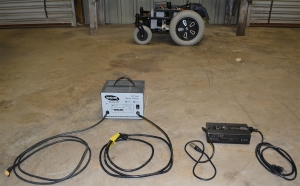Mrs. Roby is often concerned about the extent of my love for all things robotics. So I had to wait ’till she wasn’t around to write this post. Yes, it’s time for us to discuss the incomparably wonderful platform for building skid-steer rovers: The Electric Wheelchair.

So why are we so madly in love appreciative of the electric wheelchair? Here are some of the top reasons:
1. Payload Capacity — How much can this frame carry, you ask? I’ve routinely seen numbers in the 500 lb (227 kg) range for “heavy duty” models. If you need a test robot platform exceeding those specs, then you really do have a fascinating project.
2. Tried & True Power Source — Lead-acid batteries have been around for 150+ years and while they are far inferior to the new lithium batteries on many points, with a little care1 they are reliable, rugged and cheap.
3. Battle Tested Gear Motors — Yes, they call the drive assembly a Gear Motor. It’s a DC motor coupled to a reduction gearbox, a built-in shaft for mounting the wheel, and usually fitted with an electric brake (that we often disable). If you’re not interested in grabbing them cheap off Craigslist or eBay, you can pick them up new in the US for ~$600/pair. You’ll often see these motors on various combat robots.
4. Flooded Subsidized Market — Somehow apparently everyone’s grandparent is able to secure one of these $2000 wheelchairs for free that they either don’t use, or have left to the family when they passed on to another life, and the wheelchair is of no use to the family. I suppose we could devolve into a long philosophical complainypants discussion on appropriate government spending, but I’d rather just be thrilled that those of us in the USA benefit by buying such an amazing item in a soft second-hand market.
5. Huge User Community — If you’ve never checked out Burgerman at WheelChairDriver.com, you’re in for a treat. That guy is a genius.

6. Charger Included — Your friendly Craigslist seller will nearly always spring for including the charger with purchase. This charger is specially made to charge 2 12v lead-acid batteries wired together in series. You’ll notice from the picture that the form factor of the two charges is quite different, but their function is the same: they’ll supply roughly 28 volts and charge up your batteries.
You’ll notice that I’ve made no distinction between brands in this discussion. It appears to me that all the brands source basically all their parts from the same suppliers.
Note that the wheelchair above has the large 12″ (30.5 cm) wheels. Some models have smaller wheels, but for our application the big wheels are likely the better choice.
Another Warning
This robot platform weighs 152.8 lbs (69.3 kg). It’s approximately 24″ (61 cm) wide, 29″ (74 cm) long and 14″ (36 cm) tall. Wait, let’s repeat that:
THIS ROBOT WEIGHS 152.8 POUNDS (69.3 kg). THAT’S 7x THE WEIGHT OF THE AVERAGE 1 YEAR OLD CHILD.
Ok, I’m back. But friends, let’s sober up for a moment. Remember, we’re talking about unloaded weight. Our computing/sensor apparatus will add to that weight and size. We have to commit to spending considerable mental energy (and financial resources) on safety.
Until a teenager is afraid of a car, they shouldn’t drive. If you aren’t a little afraid of the unchecked potential of an electric wheelchair based robot, I don’t think you’re ready to build this kind of robot.
Let’s rest on that thought for now.
Sincerely yours,
Roby
Notes
- It’s very important not to discharge lead-acid batteries below somewhere between 10.8v and 11.6v. Both the Sabertooth controller, and the stock wheelchair controller (that we won’t use), have built in functionally to prevent over-discharging the lead-acid batteries. Here’s a nice article with specific floor voltages.


Leave a Reply